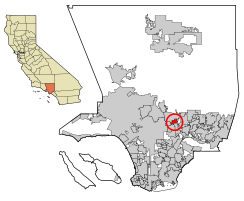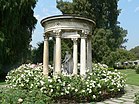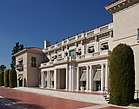User:Peterlaxamazing/sandbox
This is my (Peter Brassard's) sandbox. I am using this space to plan out new edits for important articles that need revision. It makes planning articles easy when I switch between computer to computer:) Please do not edit this without my permission!
San Marino, California[edit]
San Marino, California | |
|---|---|
|
Counter-Clockwise: Huntington Library, Huntington Gardens, El Molino Viejo; Huntington Library, El Molino Viejo. | |
| Motto(s): | |
 Location of San Marino in Los Angeles County, California | |
| Coordinates: 34°7′22″N 118°6′47″W / 34.12278°N 118.11306°W | |
| Country | |
| State | |
| County | Los Angeles |
| Incorporated | April 25, 1913[1] |
| Named for | Republic of San Marino |
| Government | |
| • Type | Council Manager |
| • Mayor | Dr. Steven W. Huang[2] |
| • Vice Mayor | Gretchen Shepherd Romey[3] |
| • City Council | City council[4] |
| • City Manager | Philippe Eskandar[5] |
| Area | |
| • Total | 3.77 sq mi (9.77 km2) |
| • Land | 3.77 sq mi (9.75 km2) |
| • Water | 0.01 sq mi (0.02 km2) 0.18% |
| Elevation | 564 ft (172 m) |
| Population (2010) | |
| • Total | 13,147 |
| • Estimate (2019)[7] | 13,048 |
| • Density | 3,464.68/sq mi (1,337.85/km2) |
| Time zone | UTC-8 (PST) |
| • Summer (DST) | UTC-7 (PDT) |
| ZIP codes | 91108, 91118 |
| Area code | 626 |
| FIPS code | 06-68224 |
| GNIS feature ID | 1652789[1] |
| Website | ci |
San Marino is a residential city in Los Angeles County, California, United States. It was incorporated on April 25, 1913. At the 2020 United States census the
population was 12,513,[8] a decline from the 2010 United States census.[9] The city is one of the wealthiest places in the nation in terms of household income.[10] By extension, with a median home price of $2,699,098,[11] San Marino is one of the most expensive and exclusive neighborhoods in the Los Angeles area.
History[edit]
Origin of name[edit]
The city takes its name from the ancient Republic of San Marino, founded by Saint Marinus who fled his home in Dalmatia (modern Croatia) at the time of the Diocletianic Persecution.[12][13]
The seal of the City of San Marino, California is modeled on that of the republic, depicting the Three Towers of San Marino each capped with a bronze plume, surrounded by a heart-shaped scroll with two roundels and a lozenge (of unknown significance) at the top. The crown representing sovereignty on the original was replaced with five stars, representing the five members of the city's governing body. Beneath the city's seal are crossed palm fronds and orange branches.[12]
The city celebrated its centennial in 2013, including publication by the San Marino Historical Society of a 268-page book, San Marino, A Centennial History, by Elizabeth Pomeroy.[14] In September 2014, this book and author Elizabeth Pomeroy received a prestigious Award of Merit for Leadership in History from the American Association for State and Local History (AASLH).[15]
Early history[edit]
The site of San Marino was originally occupied by a village of Tongva (Gabrieleño) Indians located approximately where the Huntington School is today. The area was part of the lands of the San Gabriel Mission. Principal portions of San Marino were included in an 1838 Mexican land grant of 128 acres to Victoria Bartolmea Reid, a Gabrieleña Indian. (After her first husband, also a Gabrieleño, died in 1836 of smallpox, she remarried Scotsman Hugo Reid in 1837). She called the property Rancho Huerta de Cuati. After Hugo Reid's death in 1852, Señora Reid sold her rancho in 1854 to Don Benito Wilson, the first Anglo owner of Rancho San Pascual. In 1873, Don Benito conveyed to his son-in-law, James DeBarth Shorb, 500 acres (2.0 km2), including Rancho Huerta de Cuati, which Shorb named "San Marino" after his grandfather's plantation in Maryland, which, in turn, was named after the Republic of San Marino located on the Italian Peninsula in Europe.[16][17]
History (1900s)[edit]
In 1903, the Shorb rancho was purchased by Henry E. Huntington (1850–1927), who built a large mansion on the property. The site of the Shorb/Huntington rancho is occupied today by the Huntington Library, which houses a world-renowned art collection, research and rare-book library, and botanical gardens.[18] In 1913 the three primary ranchos of Wilson, Patton, and Huntington, together with the subdivided areas from those and smaller ranchos, such as the Stoneman, White, and Rose ranchos, were incorporated as the city of San Marino.[12]
The first mayor of the city of San Marino was George Smith Patton (1856-1927), the son of a slain Confederate States of America colonel in the U.S. Civil War (also named George Smith Patton, 1833–1864). He married Ruth Wilson, the daughter of Don Benito Wilson. Their son was the World War II general George S. Patton Jr.
To a prior generation of Southern Californians, San Marino was known for its old-money wealth and as a bastion of the region's WASP gentry. By mid-century, however, other European ethnic groups had become the majority.
In the 1980s, San Marino was home to serial killer and con-man Christian Gerhartsreiter.[19] Posing as a member of the British aristocracy and relative of Louis Mountbatten, 1st Earl Mountbatten,[19] Gerhartsreiter murdered John and Linda Sohus in 1985.[19][20] Gerhartsreiter then fled to Greenwich, Connecticut and assumed a new alias. The body of John Sohus was discovered in San Marino in 1994[20] and Gerhartsreiter was later convicted of the killing in 2013. Linda Sohus' body has never been found.[19]
In 1970, the city was 99.7% White.[21] By 1990, the city's households were 23.7% Asian.[21]
In 2000, the city's Asian households increased to 40%.[21]
In recent decades, immigrants of Chinese and Taiwanese ancestry have come to represent more than 60% of the population, perhaps due to its location in the San Gabriel Valley, known to be a popular destination for East Asian immigrants.[22]
Geography[edit]
The city is located in the San Rafael Hills, and it is divided into seven zones, based on minimum lot size. The smallest lot size is about 4,500 square feet (420 m2), with many averaging over 30,000 square feet (2,800 m2). Because of this and other factors, most of the homes in San Marino, built between 1920 and 1950, do not resemble the houses in surrounding Southern California neighborhoods (with the exception, perhaps, of neighboring portions of Pasadena). San Marino has also fostered a sense of historic preservation among its homeowners. With minor exceptions, the city's strict design review and zoning laws have thus far prevented the development of large homes found elsewhere in Los Angeles.
According to the United States Census Bureau, the city has a total area of 3.8 square miles (9.8 km2), virtually all land.
San Marino is highly restrictive of commercial operations in the city. It is one of the few cities that requires commercial vehicles to have permits to work within the city. The rationale is that commercial vehicle operators and service providers, such as gardeners, pool service providers and maintenance workers, are more likely to cause social disruption within the city, and so must be preauthorized for crime control and prosecutorial purposes. This regulation and others, including the bans on apartment buildings, townhouses, and overnight parking, are some of the more obvious examples.
Demographics[edit]
| Census | Pop. | Note | %± |
|---|---|---|---|
| 1920 | 584 | — | |
| 1930 | 3,730 | 538.7% | |
| 1940 | 8,175 | 119.2% | |
| 1950 | 11,230 | 37.4% | |
| 1960 | 13,658 | 21.6% | |
| 1970 | 14,177 | 3.8% | |
| 1980 | 13,307 | −6.1% | |
| 1990 | 12,959 | −2.6% | |
| 2000 | 12,945 | −0.1% | |
| 2010 | 13,147 | 1.6% | |
| 2020 | 12,513 | [23] | −4.8% |
| 2022 (est.) | 12,039 | [24] | −3.8% |
| U.S. Decennial Census[25] | |||
2020
The 2020 United States census[26] reported that San Marino's population was 12,513 residents. This is a decline from the 2010 census, where the population was 13,147.[27] Asian Americans constituted the majority of San Marino residents at 8,061 (64.4%). White Americans were the second-largest group at 4,484 residents (35.8%). African Americans were the third-largest group at 109 residents (0.9%). American Indians or Native Americans represented 94 residents (0.8%). Native Hawaiians and Pacific Islanders represented 92 residents (0.7%). 722 residents responded as 'some other race' (5.8%).[26] 888 residents identified as Hispanic or Latino American (7.1%).
The largest age demographic were 15-19 year olds, representing 1,064 residents (8.5%). The second-largest age demographic were 55-59 year olds, representing 1,016 residents (8.1%). 9,892 residents (79.1%) were 18 years old or older and 3,519 (28.1%) were over the age of 62.[26]
According to the 2020 Census, San Marino had a median household income of $174,622, with 6.1% of the population living below the federal poverty line.[28]
2010[edit]
The 2010 United States Census[27] reported that San Marino had a population of 13,147. The population density was 3,483.4 inhabitants per square mile (1,344.9/km2). The racial makeup of San Marino was 5,434 (41.3%) White (37.1% Non-Hispanic White),[29] 55 (0.4%) African American, 5 (0.0%) Native American, 7,039 (53.5%) Asian, 2 (0.0%) Pacific Islander, 198 (1.5%) from other races, and 414 (3.1%) from two or more races. Hispanic or Latino of any race were 855 persons (6.5%).
The census reported that 13,066 people (99.4% of the population) lived in households, 81 (0.6%) lived in non-institutionalized group quarters, and 0 (0%) were institutionalized.
There were 4,330 households, out of which 1,818 (42.0%) had children under the age of 18 living in them, 3,220 (74.4%) were opposite-sex married couples living together, 367 (8.5%) had a female householder with no husband present, 143 (3.3%) had a male householder with no wife present. There were 42 (1.0%) unmarried opposite-sex partnerships, and 22 (0.5%) same-sex married couples or partnerships. Of all households, 531 (12.3%) were made up of individuals, and 359 (8.3%) had someone living alone who was 65 years of age or older. The average household size was 3.02. There were 3,730 families (86.1% of all households); the average family size was 3.28.
The population was spread out, with 3,422 people (26.0%) under the age of 18, 712 people (5.4%) aged 18 to 24, 2,353 people (17.9%) aged 25 to 44, 4,351 people (33.1%) aged 45 to 64, and 2,309 people (17.6%) who were 65 years of age or older. The median age was 45.3 years. For every 100 females, there were 92.4 males. For every 100 females age 18 and over, there were 87.7 males.
There were 4,477 housing units at an average density of 1,186.2 per square mile (458.0/km2), of which 3,959 (91.4%) were owner-occupied, and 371 (8.6%) were occupied by renters. The homeowner vacancy rate was 0.5%; the rental vacancy rate was 6.5%; 11,834 people (90.0% of the population) lived in owner-occupied housing units and 1,232 people (9.4%) lived in rental housing units.
2000[edit]
As of the census[30] of 2000, there were 12,945 people, 4,266 households, and 3,673 families residing in the city. The population density was 3,430.5 inhabitants per square mile (1,324.5/km2). There were 4,437 housing units at an average density of 1,175.8 per square mile (454.0/km2). The racial makeup of the city was 51.98% White, 0.15% African American, 0.05% Native American, 47.7% Asian, 0.08% Pacific Islander, 1.04% from other races, and 2.30% from two or more races. Hispanic or Latino of any race were 3.25% of the population. More than one-third of the city's population, 33.3%, was Chinese.[31]
There were 4,266 households, out of which 42% had children under the age of 18 living with them, 75% were married couples living together, 8.6% had a female householder with no husband present, and 13.9% were non-families. Of all households 12% were made up of individuals, and 7.3% had someone living alone who was 65 years of age or older. The average household size was 3.03 and the average family size was 3.29.
In the city, the age distribution of the population showed 26.5% under the age of 18, 6.4% from 18 to 24, 21.5% from 25 to 44, 29.4% from 45 to 64, and 16.2% who were 65 years of age or older. The median age was 43 years (this was older than average age in the U.S.).[32] For every 100 females, there were 93.1 males. For every 100 females age 18 and over, there were 89.1 males.San Marino is one of the county's cities with the highest proportion of residents of Asian ancestry. These were the ten neighborhoods in Los Angeles County with the largest percentage of Asian residents, according to the 2000 census:[33]
- Chinatown, 70.6%
- Monterey Park, 61.1%
- Cerritos, 58.3%
- Walnut, 56.2%
- Rowland Heights, 51.7%
- San Gabriel, 48.9%
- Rosemead, 48.6%
- Alhambra, 47.2%
- San Marino, 46.8%
- Arcadia, 45.4%
- ^ a b "San Marino". Geographic Names Information System. United States Geological Survey, United States Department of the Interior.
- ^ "Dr. Steven W. Huang". Retrieved December 14, 2023.
- ^ "Gretchen Shepherd Romey". Retrieved December 14, 2023.
- ^ "Mayor & City Council". www.cityofsanmarino.org. Archived from the original on Apr 5, 2023. Retrieved 10 June 2023.
- ^ "Philippe Eskandar". Retrieved November 21, 2023.
- ^ "2019 U.S. Gazetteer Files". United States Census Bureau. Retrieved July 1, 2020.
- ^ "Population and Housing Unit Estimates". United States Census Bureau. May 24, 2020. Retrieved May 27, 2020.
- ^ "Explore Census Data". data.census.gov. Retrieved 2023-06-12.
- ^ "Geographic Identifiers: 2010 Census Summary File 1 (G001), San Marino city, California". American FactFinder. U.S. Census Bureau. Archived from the original on February 13, 2020. Retrieved September 4, 2019.
- ^ del Giudice, Vincent; Lu, Wei. "America's 100 Richest Places". Bloomberg.com. Bloomberg.
- ^ "Housing in San Marino, CA". Berkshire Hathaway. Archived from the original on 2018-10-16. Retrieved 11 Oct 2017.
- ^ a b c "City of San Marino, CA - About Our City". Cityofsanmarino.org. 1917-09-09. Archived from the original on 2011-07-25. Retrieved 2010-08-04.
- ^ K.Maskarin. "St. Marino, the founder of the San Marino republic - the legend, island Rab Croatia". Kristofor.hr. Archived from the original on 2011-07-21. Retrieved 2010-08-04.
- ^ Pomeroy, Elizabeth. San Marino, A Centennial History. San Marino Historical Society, 2012.
- ^ http://about.aaslh.org/awards/ Archived 2014-10-06 at the Wayback Machine American Association for State and Local History Awards
- ^ "Historic Adobes of Los Angeles County". LAOKay.com. Archived from the original on 2014-08-25. Retrieved 2013-12-28.
- ^ "{title}". Archived from the original on 2011-07-25. Retrieved 2010-07-20.
- ^ "About The Huntington". Huntington.org. Archived from the original on 2013-12-30. Retrieved 2013-12-28.
- ^ a b c d "Rockefeller imposter and convicted felon born". HISTORY. Retrieved 2023-06-11.
- ^ a b Redd, Wyatt (2022-03-19). "Meet The Twisted Con Man Who Passed Himself Off As A Rockefeller And Got Away With Murder For 28 Years". All That's Interesting. Retrieved 2023-06-11.
- ^ a b c "How an Exclusive Los Angeles Suburb Lost its Whiteness". Bloomberg.com. citylab.com. August 27, 2012. Retrieved July 17, 2019.
- ^ "City of San Marino, CA - Employment Opportunities". Cityofsanmarino.org. Archived from the original on 2010-01-07. Retrieved 2010-08-04.
- ^ "Explore Census Data".
- ^ "U.S. Census Bureau QuickFacts: San Marino city, California".
- ^ "Census of Population and Housing". Census.gov. Retrieved June 4, 2015.
- ^ a b c "Explore Census Data". data.census.gov. Retrieved 2023-06-12.
- ^ a b "2010 Census Interactive Population Search: CA - San Marino city". U.S. Census Bureau. Archived from the original on July 15, 2014. Retrieved July 12, 2014.
- ^ https://www.census.gov/quickfacts/fact/table/sanmarinocitycalifornia,US/INC110221
- ^ "San Marino (City) QuickFacts from the US Census Bureau". Archived from the original on 2012-08-30. Retrieved 2013-11-30.
- ^ "U.S. Census website". United States Census Bureau. Retrieved 2008-01-31.
- ^ "US Census Bureau, 2000 Census factsheet". Archived from the original on 2020-02-12. Retrieved 2007-06-20.
- ^ "San Marino, California Demographics - City and State Information - Population and Housing Data". muninetguide.com. Archived from the original on 2010-08-03. Retrieved 19 March 2018.
- ^ "Asian", Mapping L.A., Los Angeles Times









